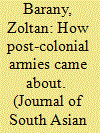| Srl | Item |
| 1 |
ID:
134244


|
|
|
|
|
| Summary/Abstract |
The creation of an army loyal to the state is one of the most important institutional tasks of post-colonial leaders. But how do novice political leaders develop the capacity to subordinate the armed forces to the authority of state institutions? This essay explains alternative methods of formulating post-colonial civil–military relations and explains why four states – India, Pakistan, Ghana, and Tanzania – took such different routes of institutional development. I make two arguments. Firstly, building armed forces that willingly acquiesce to state authority is always a critical issue of regime change – whether to democracy or some other form of government – though it is more difficult to accomplish in some contexts than others. Secondly, the political and socioeconomic contexts in which armies must be built are very different and thus pose dissimilar challenges and tasks to those crafting new armies and civil–military relations. I will assess the power of several variables to explain the disparate outcomes of the four cases: the quality of political leadership and leaders’ approach to the armed forces, the strength of political institutions, ethno-religious and regional policies, civilian control mechanisms, military–societal relations, and foreign influence.
|
|
|
|
|
|
|
|
|
|
|
|
|
|
|
|
| 2 |
ID:
135277


|
|
|
|
|
| Summary/Abstract |
This paper examines the new styles of houses under construction in contemporary Tanzania and suggests that they can be understood as the material manifestation of middle class growth. Through an examination of the architecture, interior decor and compound space in a sample of these new houses in urban Dar es Salaam and rural Kilimanjaro, the paper identifies four domestic aesthetics: the respectable house, the locally aspirant house, the globally aspirant house and the minimalist house, each of which map on to ideas about ujamaa, liberalisation and the consumption of global consumer goods in distinct ways. The paper argues that these different domestic aesthetics demonstrate intra-class differences, and in particular the emergence of a new middle class.
|
|
|
|
|
|
|
|
|
|
|
|
|
|
|
|